|
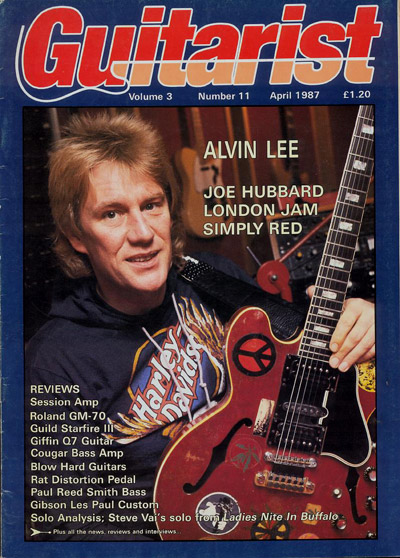
Alvin Lee – Twenty Years After The likes of Eddie
Van Halen and Yngwie Malmsteen were still running
around in nappies when Alvin Lee was the fastest
guitar in the West. With his band – Ten Years After
– Alvin captured the hopes of many aspiring string
benders, and still continues to do so in the
eighties, but he now performs under just his own
name. His latest album, “Detroit Diesel”, is just
about to be released in the UK having proved a big
success in the USA. Bob Hewitt chatted with Alvin
about his career and the new album.
The new album is my first one for about five
years. I’ve had a long lay-off, because I found
myself putting out records I didn’t like very much,
mainly because of pressure from record companies to
push another album out although I didn’t really have
the songs! The previous album was called “Freefall”:
it took about six months to come out, and then I
found myself touring around the world. I would do a
radio station and people would say, “tell me about
the new album…” and I would say “Well, I like one of
the tracks on it…” So I thought it had to stop; if I
was putting out albums I didn’t like, how could I
expect anyone else to like them? Basically, I’ve
spent the time here in my own studio finding out new
techniques and stuff like that. I’ve been doing gigs
as well, plenty of them in Europe and the USA, but
none in England. I’ve got a three piece working
band, which sometimes goes to a four piece when the
budget permits! I perform under my own name—not Ten
Years After—and I have Alan Young on drums and Steve
Gould on bass. Micky Feát played bass on the album,
and he is in the occasional four piece outfit,
because Steve can also play guitar, keyboards and
sing…clever bloke! Basically, I’ve just carried on
earning my living as a musician—that’s all I’ve ever
wanted to do. I’ve always avoided the “Rock Star”
kind of image and have never gone in for gold lame´
suits and things like that! To be honest, I think
it’s quite a privilege to be a working musician, and
to make a living out of it. That’s what my heroes
have done, like Muddy Waters and John Lee Hooker,
they’ve played ´till they’re 90 or so. Really,
that’s all I’ve ever wanted to do, I’m not into
getting hit records and retiring at an early age—I’ve
tried retiring…it’s boring.
Tell us a little
about the new album “Detroit Diesel”.
Well I think it took me a long time to find out
which direction I wanted to go in, having had five
years off. I’d heard all the new Eddie Van Halens
and things, so I thought ´How am I going to
represent myself?´ So I got back to the basic roots,
things I like, straight ahead rock ´n´ roll blues—I
figured I should do what I do best. For people who
don’t know what I do, it’s like re-introducing my
own style, and it’s probably nearer the old Ten
Years After format as far as energy goes, and I like
the songs. There is a tendency these days for record
companies to want pop songs and hit songs, they are
always looking for singles. I’ve always been an
album artiste really, and it takes a long time to
get a good song and then play it the way you want to
play it, and not lose out. Sometimes it can sound
commercial and lose some of its ethnic feel and
sometimes its ethnic and not very commercial! Now I
think I’ve brought the two together. I’ve used
computer drums and triggered synthesisers and
samplers, those kind of gadgets—really it’s old rock
with a new slant!
Most of the work
had been done here in your own studio, hadn’t it?
Yes, they are all original demo’s. I kept the same
piece of tape and changed bits here and there,
overdubbed and built it up. It actually sounds like
a live band, but it’s quite high tech. Who is on the
album with you? There’s a drummer called Bryson
Graham, Steve, Alan and Micky from my current band.
Tim Hinkley plays some keyboards, and a guy called
David Hubbard who is first class with synths. Jon
Lord plays Hammond Organ and George Harrison plays
slide guitar on a track called ´Talk Don’t Bother
Me´.
Leo Lyons from the old Ten Years After band plays
bass on the title track, ´Detroit Diesel´, and we’ve
got Joe Brown playing fiddle on another track with
his wife Vicky on backing vocals! Boz Burrell plays
bass on one track, in fact, we used to have a band
called The Gits about the time Ten Years After was
folding up which Boz and myself, Mel Collins on sax
and Ian Wallace on drums. That evolved into the
In-Flight Band which did the Live at the Rainbow
Concert, but it went a little bit too funky and
tasty for its time.
The techniques
used in making your latest album must be a far cry
from the old days, when you first recorded with Ten
Years After?
I’ll say! The first two albums
from Ten Years After were recorded live in the
studio. It was only four track in those days, but
even then I had started to get interested in studio
work. After the second album, ´Undead´, we basically
had our set `down´ so we started experimenting and
trying overdubs—all very exciting stuff in those
days. Now of course, it’s a more complicated version
of that. I still like the straight ahead technique,
because I sometimes think today’s technology is just
designed to make things take longer, and help the
studios make more money! There’s no doubt about it,
if you’ve got the songs and you rehearse enough, you
should be able to put the album down in a few days.
We always used to—those first Ten Years After
albums,
two days and that was it! …but nowadays bands go to
exotic locations in the West Indies, and it takes 6
months or longer! Oh yeah! Keyboard overdubs this
year, guitars next year…Scotty Moore is one of my
real heroes, and he did some great solos on the
Elvis records but he doesn’t like all this
overdubbing thing at all. He always went straight
onto the master tape. I remember him saying to me `I
don’t like those modern recording techniques—what I
like to hear goes down, if it ain’t goin´ down, I
don’t know what I’m doin´…´. If you’re really in
control in the studio, then you can use the latest
technology to the best results—whether it’s done in
five minutes or whatever. I remember somebody asking
if I wanted to play on a Bo Diddley album, and I
thought `great!´. I went along to the studio and
there was just an engineer who played the track and
I played my solo. Later some friends said `What was
it like to meet Bo Diddley then?´, but I never met
him: I’d played on the album but never saw a soul!
But I suppose that happens a lot now, you get bands
recording who have never actually met each other!
What about a tour to promote `Detroit Diesel´?
It’s nearly
sorted. I’ve got a few more three piece
gigs in Austria and Yugoslavia, then I think it will
be the four piece to play the stuff from the album.
I want to do gigs in this country, but I’m so out of
touch here I don’t know where to start to be
honest!
England tends to like fads and haircuts rather than
music, and I’ve found that the music press are
pretty trite and don’t really help anyone. I
remember when Ten Years After first came out and we
were doing the Marquee, people said `You’ve got to
hear this great band!´ As soon as we had success,
the same papers turned dead against us: they wrote
about´ a bunch of big headed gits who play in
America all the time´. They seem to enjoy putting
you on a pedestal and then knocking you off! It’s a
shame really, because I don’t think it reflects the
audience’s view at all. It’s the view of a narrow
minded minority—there’s always a strange faction
here in England. I remember during the blues
boom—because I was playing at that time—there were
blues `purists´. If you did an Elmore James song and
changed a note of the solo, they used to come up to
you afterwards and tell you, you hadn’t played it
`properly´. I used to really revolt against that,
because you can play what you like as long as it
sounded like a blues number. It’s funny you know,
they all used to wear long leather jackets and stand
around the front of the stage making notes! My
musical style seems to have gone right around the
houses, because I started out playing jazz and blues, then went into rock, then deeper into jazz
and funk. I went off all the Ten Years After
numbers—I even refused to play Goin´ Home for about
a year! I’ve come back to it all now. I think it’s
just a phase you go through, because a lot of
artistes turn against the numbers they are famous
for. I remember Hendrix used to dislike Hey Joe
which used to baffle me, because I thought it was a
great song, in fact, I do it in my set now and it
goes down a bomb!
What happened to Ten Years After—was it just the
natural demise of a band?
Well we were together for
nearly eight years, which is a pretty good run!
After about eleven albums I think we realised we had
gone as far as we could. In fact, we overworked in
those early years, because every band starting off
wants to fill the date sheets—and we worked for six
years solid: it was six months in the States, back
here for a day off, over to Germany for two months,
another day off, then Italy and so on… Suddenly
you’re due in the studio for an album, so you
think, `Better write some songs then!´. We used to write
songs in the taxi on the way to the recording
session! I think another reason for wrapping it up,
was to settle down with our families.
So the last time you all played together was the
Marquee Anniversary?
Yes that’s right, followed by
the Reading Festival. It was great and I actually
thought somebody would say it was good to see Ten
Years After together again and suggest we do it
again, but nobody seemed to notice, so I let it go.
You had quite a bit of chart success with your
early singles…..
Yes, we were in the top five with
`Love Like A Man´ and `Love To Change The World´ was
pretty big as well. But that was almost a sideline,
because they weren’t the strong numbers in the set.
We had Goin´Home and Good Mornin´ Little
Schoolgirl,
they were the show stoppers at a live performance,
but the singles were pulled off the album by the
record company.
Talking about the early days, how did your
musical career start?
Well, my father used to
collect very ethnic blues records, like chain gang
and work songs, so that was an early influence. Dad
also played a bit on guitar, with my mother and
sister, they had a country and western singing
band—very small time, local church hall jobs! There
was always a guitar lying around—we were a very
musical family—but at the age of twelve I started
playing the clarinet, although I’m never really sure
why, because I didn’t like the thing! With the
clarinet I started listening to Benny Goodman music,
but I found I was hearing more from Charlie
Christian than I was from Benny Goodman. To my
parents´ horror, I swapped the clarinet for a guitar
and spent a year learning jazz chords—vamping chords
and listening to Barney Kessell and Django Reinhardt
. Then the rock `n´ roll explosion hit England from
America, and I think Chuck Berry was the one for
me—in a way it was all the blues I was used to,
melted into rock `n ´roll, so I could understand it.
I started playing lead guitar and I didn’t think the
jazz chords were much use at all but in fact they
came in very useful later on. I never used to copy
things note for note, but just get the basic feel,
doing it my way, and I think that’s how my style
developed. I was Nottingham born and bred and used
to play in bands around that area—in fact, I played
with my first band, Alan Upton and the Jailbreakers,
when I was thirteen years old at the Sandiacre
Palace Cinema! Then there was Vince Marshall and the
Squarecaps. I used to play lead guitar with that,
and I would watch `Oh Boy´ on the TV and see Joe
Brown and Eddie Cochran. That was the first time I’d
ever seen a Bigsby tremolo arm, so I went down to
Dad’s shed to make one! I got this metal thing and
stuck it on my guitar, went to the gig that night at
the church hall. We were doing `Milk Cow Blues´. It
got around to my big tremolo solo, I got hold of the
arm, shook it and broke all six strings!!! Believe
me there’s nothing more useless than a guitar with
no strings—I just stood there and went `Argh´!. That
first guitar was a Guyatone—Hank Marvin had one for
a short while. Then I had a `Burns Tri Sonic´, which
was an awful thing to play, but it had a good jazz
sound on the front pickup. After that came a `Grimshaw´--the sort of poor man’s
`Gibson´--which I
traded for my first proper Gibson.
How were Ten Years After formed?
I was with a
band called The Atomites. Leo (Lyons) was playing
bass. He was the first bass player I met who was
keen on Bill Black; in fact, Leo is one of the few
players who can make an electric bass sound like a
slap stand up. So I was Scotty Moore and he was Bill
Black! We used to do `That’s Alright Momma´ and
stuff like that. We changed the name from the
Atomites to the JayMen, then to the JayCats and then
the JayBirds! The JayBirds got to be quite well
known in Nottingham in the early 60’s, and that
basically was the Ten Years After line up that moved
to London. But we still returned to do Saturday
night gigs in Nottingham!
…so you more or less turned semi-pro?
Well
yes,
sort of. You see, I was just waiting to get out of
school, because I was playing anyway and I was very
lucky with my parents, because I was coming home
from gigs at 1 am when I was only 14! I didn’t go
into an ordinary job; I’ve been a full time musician
since leaving school. At least it meant I could have
a sleep-in in the mornings! My parents used to ask
when I was going to get a proper job! The third time we went down to London, we got a
job in the West End at The Prince Of Wales Theatre,
so we were the band in the pub scene of `Saturday
Night and Sunday Morning´. That was quite good, it
meant regular money and enabled us to set up in
London, but the play only ran for five weeks, so
after that we ended up backing `The Ivy League on
the cabaret circuit. The door really opened for us when John Mayall
broke open the blues scene. We did a residency at
the Marquee club when we were known as `The
Bluesyard´, but we thought that name would tie us
down too much to blues, so we changed it to Ten
Years After. The Marquee gig led to the Windsor
Festival and then the whole London club circuit.
We got a record deal by word of mouth really. The
offer came through to our management for us to make
an album—in fact, I think we were one of the first
bands to make an album without making a single
beforehand. At that time. The music was described as
`underground´ and I quite liked that—the fact that
you don’t have to dress up to go on stage was
great!
To be able to go on in `T´ shirt and jeans and
tennis shoes—that was freedom! We used to wear these
little leather things and try to look smart before,
and I used to hate all that—although I was an Elvis
fan, I would never have dared to wear a lame´ suit
or anything like that!
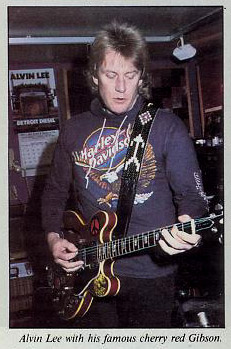
How did your `superfast´ technique develop?
Basically it just came from the excitement of
playing live—the adrenalin. I used to hear tapes of
the band from the mixing desk after a show, and
sometimes I couldn’t believe it was me playing! I
really didn’t know I could play like that—Ten Years
After was all about excitement and energy. I
basically played guitar `from the hip´, an instinct
or reaction if you like, because I’m not one for
practicing, I’m a `jammer´. My attitude was to `go
for it´, and on a good night I could get it. I
sometimes didn’t know what I was doing and
occasionally would mess it up, but I’d bluff my way
through with conviction. It’s like the old story—if
you play a horrible note, play it again and people
will think you meant to do it! I think you improve
when you make mistakes; if you play perfectly all
the time, then you are playing too much within your
boundaries, it’s time to push the boundaries and see
how far you can get. All the work in a studio to do
an album, that’s real work, but the fun part is
going out on the road and playing live!
Talking of playing live, you did some `mega´gigs…
Woodstock was a particularly good memory for me. It
needn’t have been, had it all gone to schedule,
because we would have just flown in on the
helicopter and then flown straight out again, but
there was a thunderstorm just before we were due to
go on stage, so we had about three hours to wait. I
walked around the audience and around the lake, and
really got into it all—fantastic! When the movie of
Woodstock came out, about a year after the actual
festival, Ten Years After really took off. It was
our spot on the movie that accelerated the band up
to the 20,000 seater gigs instead of the usual 5,000
seaters. There isn’t much satisfaction playing the
big auditoriums though—you can’t hear anything,
can’t see anything. You just see the security men,
usually with cotton wool in their ears. That doesn’t
really encourage you to play your best! To me, the
Marquee is what gigs are all about; a thousand
people crammed together with sweat dripping down the
walls. It’s hot and the music is loud, and you can’t
get away from it—that’s really what I like. The
American clubs that I do are all like that. They’re
slightly bigger than the Marquee, but it’s all back
to the blues again and that’s how I cut my teeth.
Have you seen any artistes on your travels who
have taken your attention…?
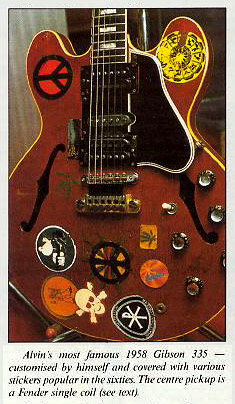
Well I like Mark
Knopfler, his style is quite different and foreign
to me, but I like that fingerpicking. That’s my
hobby style really. I don’t think I could ever do it
professionally. I think Gary Moore is probably the
`hot boy´ right now, in fact, he came to a gig we
did in Ireland on a school roof! I met him about a
year ago and he told me he was in the audience in
the playground. He was at that impressionable
age—while I was watching Chuck Berry, Gary Moore was
watching Alvin Lee! He’s a very fine and technical
musician—he can play practically anything. It’s good
to be a motivator you know. I sometimes hear someone
playing my licks—the ones that have become a bit `trade-markish´--and that’s quite a nice
buzz, makes
you feel a bit like a teacher. And I think, as you
get older, that is one of the best things you could
possibly be, to pass on the things you know. Freddy
King was one of my favourites—one of the original
string benders! It’s a funny thing about string
bending, because I started off like Charlie
Christian with a 28 gauge wound third string—and
there’s no bending them at all! And then I heard
Freddy King and it was like a door being opened to
me—all these new licks waiting. The same with Chuck
Berry—playing solos on more than one note at a
time—that was a breakthrough that kept me busy for
about a year, exploring all the different
combinations. The more you know, it kind of gets
slower and slower—the less new things there are to
pick up. The hammer-on with the right hand was
probably the latest thing, but they’re getting fewer
and farther between—I’m happy now to stumble across
a new progression, maybe once a month or something.
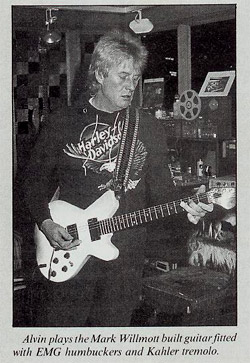 But I notice on a couple of your guitars you have
Kahler tremolo systems, and I don’t think we’ve ever
seen you use one on stage. But I notice on a couple of your guitars you have
Kahler tremolo systems, and I don’t think we’ve ever
seen you use one on stage.
That’s right. Actually I
was a bit of purist before I got hung up on them,
but I used one in the studio and I wanted to get the
same effect live, so I put one on a stage
guitar—just in case. But I’m a convert now—put
Kahlers on everything, piano, saxophone drums…!!!
Have you done any session work with other
artistes or friends?
Well, Gary Moore lives nearby
and we’ve had a few jams—but nothing on tape yet.
But it’s funny being, for want of a better word, a
`legendary´ guitarist, I don’t get as much other
work as I’d like. People tend to think ´Oh, he
doesn’t need any work´ so they don’t ask me but, as
a matter of fact, I’d love to do it. So I’m putting
out a call in Guitarist Magazine—anyone who wants
some session work, I’ll do it—and I won’t charge a
fortune either!!!
And you have the advantage of owning your own
studio…
I’ve been interested in studio technique
since the very early days at Olympic—a sort of
amateur engineer if you like; I really enjoy it. I
get bands in here to do demos—and proper tracks as
well, but I’m an amateur engineer because I’d hate
for anyone to be relying on me. But occasionally, if
I’m not under pressure, I can get really good
sounds—but I can’t guarantee! I think having a
background knowledge makes you a better recording
musician, and it’s taken years because it is only
recently that it’s all started coming together,
logically. It’s always been a kind of mystery—and
that’s what makes it so interesting. In the early
studio days you used to go in to record, and they
wouldn’t even let you hear it back! They would say
`That was fine, now what else have you got…´ Having
this place is great for experiments and ideas; you
can just pick up your guitar, switch on and away you
go—instead of losing ideas. Really, for a
professional musician and a recording musician, it’s
down to the songs and the creativity. Playing is fun
and song writing is hard, actually creating music is
hard. That’s where the work comes in and where the
time is consumed. I’ve probably got about 500 hours
of great jams on 16 track; I’ve had all sorts of
great musicians down here, but we all play in E for
half an hour or A for half an hour. It’s some of my
favourite music, but you can’t do anything with it.
Do you try and escape from those common blue
keys?
Well yeah, that’s the whole trick. It’s
finding something that goes with E that isn’t A—but
sounds as natural, that’s the hard thing. You have
got to make it flowing and natural and not fall into
the three chord trap. Basically I like 12 bar and I
like three chords. The thing is to use four chords
and that’s where the jazz and the funk got me out of
that—an easy way out. I’m still trying to make basic
rock `n´ roll sound like 12 bar with three
chords—but not use those three chords! I’ve always
found that, no matter what you do performance-wise
in front of the general public, I’m always aware of
what other musicians think. Sometimes there will be
one guy in the front row and you can tell he’s a
guitarist because his eyes are transfixed on your
left hand! Suddenly I think I’d better watch it
because this guy is watching me very closely—so I’d
better come up with something good here…!
Presumably, when you do a gig nowadays, it’s
obligatory to pull out some of the old favourites?
Well, I enjoy it. It’s always been obligatory and I
revolted against it for a while. In fact, when I had
the `In Flight´ album, I did a set that had no Ten
Years After numbers in it at all—I thought I would
have a change after 8 years of the same material, so
I was playing funky and jazzy stuff with Mel
Collins. But I remember going to see Jerry Lee Lewis
in Birmingham and he did all country music—no Great
Balls Of Fire or any of the well-known stuff and I
was really upset. So, from that night on, I thought
maybe people who came to see me would be
disappointed if I didn’t do the favourites. From
then on I’ve never had any reservations about
playing them. I mean, if you’re making money, then
you’ve got to give people what they like. It’s fine
to be a musician but if the public are paying to see
you they want entertaining, and you have to play
what they want. Actually, that was quite a
turn-around for me, because I was quite a reluctant
entertainer for most of those Ten Years After
years—I used to play a bit begrudgingly sometimes. I
mean that happens; you get to the point where you
walk on stage and everyone is cheering before you’ve
even played a note. Some nights you would play
pretty badly, in your own estimation, and nobody
would seem to notice—other nights I would play
really well and no one would seem to notice either!
It’s a difficult pill to swallow: you begin to think
`What am I really doing—just being a cardboard
cut-out and going on stage to do these songs, like a
juke-box´. I think that attitude comes from doing
too much, because we used to work all the time and
had hardly any time to write songs, so the set
stayed pretty much the same for about five years!
But I’m enjoying it now, because I’m not working to
that intense level—I’ve actually enjoyed the last
five years touring without an album—it’s been
great.
You don’t have all those interviews and all that
circus thing to do, but the new album is out now so
I think I’ve got to go out and work a bit more. But
that’s good too, because you’ve got to stretch. I’ve
actually found a lot more enjoyment in playing now
that I’ve got back to the kind of gigs I like—and
the kind of music. It’s just taken me this long to
work it all out in my own head. I used to be out on
the stage wondering what I was doing it for. Now I
know what I’m doing it for, and that means a lot.
When there are times that I get a bit rough on the
road—and I love being on the road, but there are
bound to be times when you think `What the hell am I
doing this for?´ Really, you’ve got to be doing it
for yourself because if you’re doing it for other
people you start resenting it. If you’re doing it
because your manager has made you, then you start
not liking the manager, but I have a much more
mature attitude nowadays. But getting back to the
old numbers, they will all be in with the new set
from the Detroit Diesel album—Goin`Home, Good
Mornin´ Little Schoolgirl, and Help Me Baby. They
are key numbers in the set, because you have to open
with a strong number and then you can play a blues
or back off a bit—Schoolgirl is always a lift to
start things off. Love Like A Man is a very simple
riff that goes down a bomb—I meet lots of people who
tell me it’s the first thing they learnt to play on
guitar. It’s easy to play, but when you play live it
still works. I don’t know why it is, there is no
secret in any particular combination of notes, it’s
just certain notes together really click. I think
you can get over-complex and play something that
sounds good to us as musicians, but it goes right
over the heads of the audience—it’s what pleases the
ears that matters.
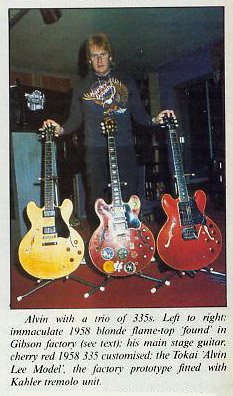 Well we are sitting here in your studio Alvin,
and I see the room is full of guitars, so you are
obviously something of a collector… Well we are sitting here in your studio Alvin,
and I see the room is full of guitars, so you are
obviously something of a collector…
That’s right,
and here is my famous 1958 Gibson 335 that I bought
for £45 in Nottingham—best investment I ever
made—even had a fitted case!
How did it come to be covered in so many
stickers?
Well, they just got thrown on
actually.
But when I broke the neck at The Marquee, owing to
the ceiling being so low, I sent it back to Gibson
for repair and when it was returned, they had
lacquered over all the stickers—so they couldn’t
come off anyway!
You’ve done some work to the 335 yourself over
the years…
Oh yes, I’m a keen dabbler! I’m always
changing pickups and re-wiring. The Gibson has the
original 1958 PAF humbuckers with the covers removed, and a Fender pickup in the middle to give a
bit more top—it’s good for the studio—lots of cut
and fizzytop. I used to buy Hofner and DeArmond
pickups and mess about with those as well. The 335
is still my main guitar: I think it’s the size of
the body—it fits me quite well. I love to play
Strats but I prefer to play them sitting down for
some reason. I enjoy Les Pauls, but they feel too
small and heavy. I’m just used to the 335. I bought
this old Strat from a girl in Texas, who took
lessons for a week and then put the guitar in the
attic, along with this lovely Fender tweed amp.
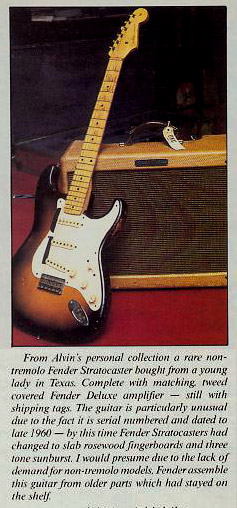 The
whole lot only cost 400 dollars; they didn’t seem to
value old guitars so much then. The most I’ve ever
paid is 1,400 dollars for this 1958 335, which was
`lost´ at the Gibson factory and found later under a
pile of old wood. It was cased, so it’s totally
unmarked with the most beautiful blonde flamed
top—just lost in the factory for twenty years! Dave
Edmunds is after it actually… When we were touring
the States, my guitar would be in the equipment
truck, and I wanted one to play in the hotel room.
So at the beginning of each tour, I would go into
stores and try find interesting guitars—like this
Gretsch Chet Atkins. It’s got a good acoustic sound
as well, so I could play it in the hotel room
without an amplifier—this was the days before
Pignose amps! The
whole lot only cost 400 dollars; they didn’t seem to
value old guitars so much then. The most I’ve ever
paid is 1,400 dollars for this 1958 335, which was
`lost´ at the Gibson factory and found later under a
pile of old wood. It was cased, so it’s totally
unmarked with the most beautiful blonde flamed
top—just lost in the factory for twenty years! Dave
Edmunds is after it actually… When we were touring
the States, my guitar would be in the equipment
truck, and I wanted one to play in the hotel room.
So at the beginning of each tour, I would go into
stores and try find interesting guitars—like this
Gretsch Chet Atkins. It’s got a good acoustic sound
as well, so I could play it in the hotel room
without an amplifier—this was the days before
Pignose amps!
When I got home to England, I would
just hang them up and buy another one on the next
tour and so on. I never really wanted or needed 40
or so guitars, it was just easier than taking them
back once you had got an American guitar over to
England. I’ve got about six 335’s, including a 12
string, and if I ever find a half decent red one,
I’ll get it anyway and try and make it into a stage
guitar. My original red 335 has done every gig with
me, up until December of 1986, and then the Tokai
company came along and measured everything to make
an exact replica of it. To finish off I got Mark
Willmott, who does my serious guitar work, to fit a
Kahler and shave the neck a little. Tokai were going
to put this model into production--`The Alvin Lee
Model´ --but they have stopped the production of
semi-solids at the moment, so it could be another
rarity to hang on the wall.
Basically I’d like to
get together with some company and get a model into
production—I’ve never even had a spare stage
guitar,
I just take the one and change the strings before
the set. If a string breaks, it’s a quick drum solo
while I change it! I wanted a Fender six string
bass, but ended up with this Rickenbacker which is
quite rare and unusual. I’ve got a Wal bass which I
like—I’m quite keen on playing bass now.
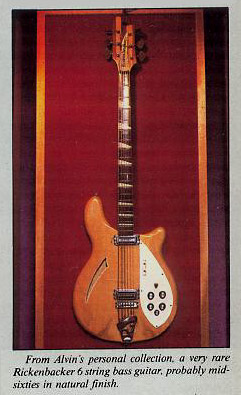 What about your onstage set up, what happens
after the guitar? What about your onstage set up, what happens
after the guitar?
Curly lead…!! I tried those radio
transmitters once—for about an hour, until one of
the crew came along and said `Where’s your lead?
That’s not rock ´n´ roll´. I thought he was dead
right, so I scrapped it. I had the radio, but I was
still turning around and stepping over an imaginary
lead anyway!! It didn’t sound the same as a lead
though. You see my guitar is matched perfectly to
this old 50 watt Marshall I’ve got; it’s ancient! In
fact a guy came down here from Marshall –Mike his
name was—and he said it was built before his time,
he found a component in there he didn’t even know
about! I don’t know about pre-amps and foot pedals.
I think the answer is to get an amplifier input
level that matches your guitar perfectly. I use the
50 watt Marshall full up—I mean people used to think
we were loud because I used to use 10 Marshall
cabinets one time—but I only had the one 50 watt
amp. I liked the dispersion! I tried the 100 watt,
but it was too `middley´ I prefer the 50, flat
out—it’s great.
You’ve got a Roland guitar synth in the corner…
Yes, it’s a present from George Harrison. He got
bored with it—and I got bored with it too. It’s
fun.
But it’s more of a toy unless you know particularly
what you want to get out of it. Then I find you are
not playing a guitar like a guitar—it’s easier to
use a keyboard to get those sounds.
How did you manage in those early days when there
was no such thing as light gauge strings?
Because of my early jazz
leanings, I was quite late changing over. I just used a first string on the third or
something like that to start with, but I’ve always
liked heavy strings. The set I use now are 54, 44,
28, 15, 12, 9. I did a gig with Frank Zappa once and
at the end we decided to have a little jam, so I, so
I played bass and gave him my guitar—but he couldn’t
play it! The action was up a bit and he likes it
laying on the frets—one of the things I noticed
about Gary Moore, he has a high action and heavy
strings. I like a big heavy bass string to hit that
with gusto.
What about the guitar you used for the Roger
Chapman tracks?
It’s built by Mark
Willmott, but we
are still working on the shape—it’s not quite right
just yet. Actually we need a name for it, so if any
of your readers have a good idea let us know. It
gives a great sound, and I used a Rockman for the
tracks you heard—I think the Rockman covers most
needs—clean and dirty. I’ve got some interesting
little WEM Dominator amps—15 watt output with one
12´´ Celestion—sounds like a stack of Marshalls when
you mike them up. For live work though, it’s the
335—curly lead and the Marshall—no effects!
We’ve got two gentlemen here in the studio who
have been your assistants for how long?
Nineteen
years! John Hembrow and Andy Jaworski. John is my
tour manager and Andy is the sound man—they help
they help with everything—guitars, amps, door
hinges,
car repairs! We’ve been all over the world together
and we’re just off to Yugoslavia and Austria with
the three piece, then hopefully when the album is
released here, some UK dates. Who knows, we might
link up in the Blue Bore Café one night on the way
up to Newcastle! Just like the good old days… It’s
funny, I don’t know where to play in England—like
the Universities have probably never heard of me
these days—same with the little clubs—it’s
difficult.
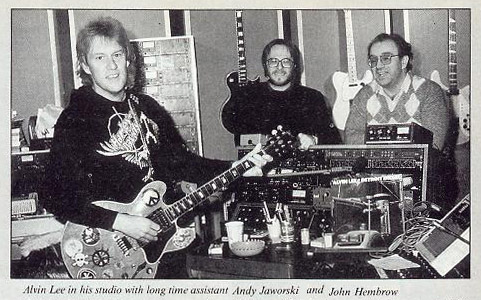
Maybe it’s time to go out and educate the masses
again—not Ten Years After but Twenty Years After?
Could be the case—yes!! I think that’s it in a
nutshell. I’ve got to get out and about and be seen
again—I can’t think of anything better to do anyway—it
beats watching television, that’s for sure!
Article written by, Bob Hewitt
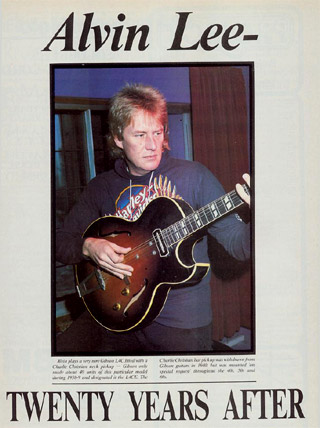
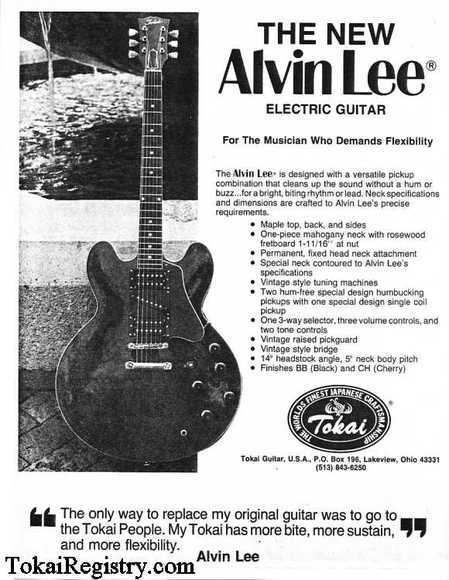
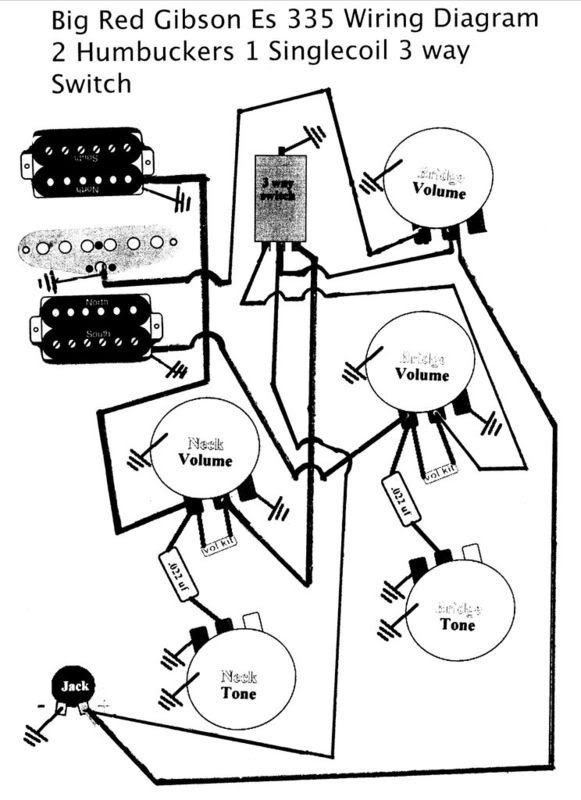
|